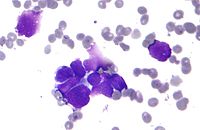
Photo from wikipedia
Background The aim of this study was to establish and validate a nomogram model for accurate prediction of patients’ survival with T1aN0M0 none small cell lung cancer (NSCLC). Methods The… Click to show full abstract
Background The aim of this study was to establish and validate a nomogram model for accurate prediction of patients’ survival with T1aN0M0 none small cell lung cancer (NSCLC). Methods The patients, diagnosed with the stage IA NSCLC from 2004–2015, were identified from the Surveillance, Epidemiology and End Results (SEER) database. The variables with a P-value < 0.05 in a multivariate Cox regression were selected to establish the nomogram. The discriminative ability of the model was evaluated by the concordance index (C-index). The proximity of the nomogram prediction to the actual risk was depicted by a calibration plot. The clinical usefulness was estimated by the decision curve analysis (DCA). Survival curves were made with Kaplan–Meier method and compared by Log–Rank test. Results Eight variables, including treatment, age, sex, race, marriage, tumor size, histology, and grade were selected to develop the nomogram model by univariate and multivariate cox regression. The C-index was 0.704 (95% CI, 0.694–0.714) in the training set and 0.713 (95% CI, 0.697–0.728) in the test set, which performed significantly better than 8th edition AJCC TNM stage system (0.550, 95% CI, 0.408–0.683, P < 0.001). The calibration curve showed that the prediction ability of 3-years and 5-years survival rate demonstrated a high degree of agreement between the nomogram model and the actual observation. The DCA curves also proved that the nomogram-assisted decisions could improve patient outcomes. Conclusion We established and validated a prognostic nomogram to predict 3-years and 5-years overall survival in stage IA NSCLC.
Journal Title: Frontiers in Medicine
Year Published: 2022
Link to full text (if available)
Share on Social Media: Sign Up to like & get
recommendations!